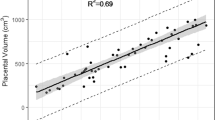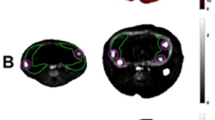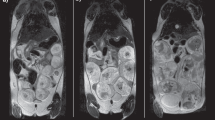Abstract
Objective:
The relationship between placental and fetal brain growth is poorly understood and difficult to assess. The objective of this study was to interrogate placental and fetal brain growth in healthy pregnancies and those complicated by fetal growth restriction (FGR).
Study Design:
In a prospective, observational study, pregnant women with normal pregnancies or pregnancies complicated by FGR underwent fetal magnetic resonance imaging (MRI). Placental, global and regional brain volumes were calculated.
Results:
A total of 114 women (79 controls and 35 FGR) underwent MRI (median gestational age (GA) 30 weeks, range 18 to 39). All measured volumes increased exponentially with advancing GA. Placental, total brain, cerebral and cerebellar volumes were smaller in FGR compared with controls (P<0.05). Increasing placental volume was associated with increasing cerebral and cerebellar volumes (P<0.05).
Conclusion:
Quantitative fetal MRI can accurately detect decreased placental and brain volumes in pregnancies with FGR and may provide insight into the timing and mechanisms of brain injury in FGR.
This is a preview of subscription content, access via your institution
Access options
Subscribe to this journal
Receive 12 print issues and online access
$259.00 per year
only $21.58 per issue
Buy this article
- Purchase on Springer Link
- Instant access to full article PDF
Prices may be subject to local taxes which are calculated during checkout





Similar content being viewed by others
References
Neerhof MG, Thaete LG . The fetal response to chronic placental insufficiency. Semin Perinatol 2008; 32 (3): 201–205.
Cohen E, Baerts W, van Bel F . Brain-sparing in intrauterine growth restriction: considerations for the neonatologist. Neonatology 2015; 108 (4): 269–276.
Brandt I, Sticker EJ, Lentze MJ . Catch-up growth of head circumference of very low birth weight, small for gestational age preterm infants and mental development to adulthood. J Pediatr 2003; 142 (5): 463–468.
Cruz-Martinez R, Figueras F, Oros D, Padilla N, Meler E, Hernandez-Andrade E et al. Cerebral blood perfusion and neurobehavioral performance in full-term small-for-gestational-age fetuses. Am J Obstet Gynecol 2009; 201 (5): 474 e1–474 e7.
Eixarch E, Meler E, Iraola A, Illa M, Crispi F, Hernandez-Andrade E et al. Neurodevelopmental outcome in 2-year-old infants who were small-for-gestational age term fetuses with cerebral blood flow redistribution. Ultrasound Obstet Gynecol 2008; 32 (7): 894–899.
Guellec I, Marret S, Baud O, Cambonie G, Lapillonne A, Roze JC et al. Intrauterine growth restriction, head size at birth, and outcome in very preterm infants. J Pediatr 2015; 167 (5): 975–81 e2.
Baschat AA . Neurodevelopment following fetal growth restriction and its relationship with antepartum parameters of placental dysfunction. Ultrasound Obstet Gynecol 2011; 37 (5): 501–514.
Baschat AA . Neurodevelopment after fetal growth restriction. Fetal Diagn Ther 2014; 36 (2): 136–142.
Messerschmidt A, Baschat A, Linduska N, Kasprian G, Brugger PC, Bauer A et al. Magnetic resonance imaging of the placenta identifies placental vascular abnormalities independently of Doppler ultrasound. Ultrasound Obstet Gynecol 2011; 37 (6): 717–722.
Quant HS, Sammel MD, Parry S, Schwartz N . Second-trimester 3-dimensional placental sonography as a predictor of small-for-gestational-age birth weight. J Ultrasound Med 2016; 35 (8): 1693–1702.
Effendi M, Demers S, Giguere Y, Forest JC, Brassard N, Girard M et al. Association between first-trimester placental volume and birth weight. Placenta 2014; 35 (2): 99–102.
Hadlock FP, Deter RL, Harrist RB, Park SK . Estimating fetal age: computer-assisted analysis of multiple fetal growth parameters. Radiology 1984; 152 (2): 497–501.
Poljak B, Agarwal U, Jackson R, Alfirevic Z, Sharp A . Diagnostic accuracy of individual antenatal tools for prediction of small-for-gestational age at birth. Ultrasound Obstet Gynecol 2017; 49 (4): 493–499.
Stirnemann J, Villar J, Salomon LJ, Ohuma E, Ruyan P, Altman DG et al. International estimated fetal weight standards of the INTERGROWTH-21st Project. Ultrasound Obstet Gynecol 2017; 49 (4): 478–486.
Fenton TR . A new growth chart for preterm babies: Babson and Benda's chart updated with recent data and a new format. BMC Pediatr 2003; 3: 13.
Fenton TR, Kim JH . A systematic review and meta-analysis to revise the Fenton growth chart for preterm infants. BMC Pediatr 2013; 13: 59.
Almog B, Shehata F, Aljabri S, Levin I, Shalom-Paz E, Shrim A . Placenta weight percentile curves for singleton and twins deliveries. Placenta 2011; 32 (1): 58–62.
Ebbing C, Rasmussen S, Kiserud T . Middle cerebral artery blood flow velocities and pulsatility index and the cerebroplacental pulsatility ratio: longitudinal reference ranges and terms for serial measurements. Ultrasound Obstet Gynecol 2007; 30 (3): 287–296.
Yushkevich PA, Piven J, Hazlett HC, Smith RG, Ho S, Gee JC et al. User-guided 3D active contour segmentation of anatomical structures: significantly improved efficiency and reliability. Neuroimage 2006; 31 (3): 1116–1128.
Andescavage N, Yarish A, Donofrio M, Bulas D, Evangelou I, Vezina G et al. 3-D volumetric MRI evaluation of the placenta in fetuses with complex congenital heart disease. Placenta 2015; 36 (9): 1024–1030.
Tustison NJ, Avants BB, Cook PA, Zheng Y, Egan A, Yushkevich PA et al. N4ITK: improved N3 bias correction. IEEE Trans Med Imaging 2010; 29 (6): 1310–1320.
Serag A, Aljabar P, Ball G, Counsell SJ, Boardman JP, Rutherford MA et al. Construction of a consistent high-definition spatio-temporal atlas of the developing brain using adaptive kernel regression. Neuroimage 2012; 59 (3): 2255–2265.
Machin D . Sample Size Tables for Clinical Studies,2nd edn. Blackwell Science: Oxford, UK; Malden, MA, USA, 1997,x, 315 pp.
Hintze J . PASS 11. NCSS, LLC. 11 edn. Kaysville, UT, USA. www.ncss.com.2011.
StataCorp. Stata Statistical Software: Release 13 edn. StataCorp LP: College Station, TX, 2013.
Arcangeli T, Thilaganathan B, Hooper R, Khan KS, Bhide A . Neurodevelopmental delay in small babies at term: a systematic review. Ultrasound Obstet Gynecol 2012; 40 (3): 267–275.
Bickle Graz M, Tolsa JF, Fischer Fumeaux CJ . Being small for gestational age: does it matter for the neurodevelopment of premature infants? A cohort study. PLoS ONE 2015; 10 (5): e0125769.
McCarton CM, Wallace IF, Divon M, Vaughan HG Jr . Cognitive and neurologic development of the premature, small for gestational age infant through age 6: comparison by birth weight and gestational age. Pediatrics 1996; 98 (6 Pt 1): 1167–1178.
Gutbrod T, Wolke D, Soehne B, Ohrt B, Riegel K . Effects of gestation and birth weight on the growth and development of very low birthweight small for gestational age infants: a matched group comparison. Arch Dis Child Fetal Neonatal Ed 2000; 82 (3): F208–F214.
Rogne T, Engstrom AA, Jacobsen GW, Skranes J, Ostgard HF, Martinussen M . Fetal growth, cognitive function, and brain volumes in childhood and adolescence. Obstet Gynecol 2015; 125 (3): 673–682.
Lohaugen GC, Ostgard HF, Andreassen S, Jacobsen GW, Vik T, Brubakk AM et al. Small for gestational age and intrauterine growth restriction decreases cognitive function in young adults. J Pediatr 2013; 163 (2): 447–453.
Tideman E, Marsal K, Ley D . Cognitive function in young adults following intrauterine growth restriction with abnormal fetal aortic blood flow. Ultrasound Obstet Gynecol 2007; 29 (6): 614–618.
Tanis JC, Van Braeckel KN, Kerstjens JM, Bocca-Tjeertes IF, Reijneveld SA, Bos AF . Functional outcomes at age 7 years of moderate preterm and full term children born small for gestational age. J Pediatr 2015; 166 (3): 552–8 e1.
de Bie HM, de Ruiter MB, Ouwendijk M, Oostrom KJ, Wilke M, Boersma M et al. Using fMRI to investigate memory in young children born small for gestational age. PLoS ONE 2015; 10 (7): e0129721.
Babenko O, Kovalchuk I, Metz GA . Stress-induced perinatal and transgenerational epigenetic programming of brain development and mental health. Neurosci Biobehav Rev 2015; 48: 70–91.
Yang CJ, Tan HP, Du YJ . The developmental disruptions of serotonin signaling may involved in autism during early brain development. Neuroscience 2014; 267: 1–10.
Debnath M, Venkatasubramanian G, Berk M . Fetal programming of schizophrenia: select mechanisms. Neurosci Biobehav Rev 2015; 49: 90–104.
Paquette AG, Marsit CJ . The developmental basis of epigenetic regulation of HTR2A and psychiatric outcomes. J Cell Biochem 2014; 115 (12): 2065–2072.
Walker CK, Ashwood P, Hertz-Picciotto I . Preeclampsia, placental insufficiency, autism, and antiphospholipid antibodies-reply. JAMA Pediatr 2015; 169 (6): 606–607.
Ostgard HF, Lohaugen GC, Bjuland KJ, Rimol LM, Brubakk AM, Martinussen M et al. Brain morphometry and cognition in young adults born small for gestational age at term. J Pediatr 2014; 165 (5): 921–7 e1.
Keunen K, Kersbergen KJ, Groenendaal F, Isgum I, de Vries LS, Benders MJ . Brain tissue volumes in preterm infants: prematurity, perinatal risk factors and neurodevelopmental outcome: a systematic review. J Matern Fetal Neonatal Med 2012; 25 (Suppl 1): 89–100.
Sanz-Cortes M, Egana-Ugrinovic G, Zupan R, Figueras F, Gratacos E . Brainstem and cerebellar differences and their association with neurobehavior in term small-for-gestational-age fetuses assessed by fetal MRI. Am J Obstet Gynecol 2014; 210 (5): 452 e1–452 e8.
Egana-Ugrinovic G, Sanz-Cortes M, Figueras F, Couve-Perez C, Gratacos E . Fetal MRI insular cortical morphometry and its association with neurobehavior in late-onset small-for-gestational-age fetuses. Ultrasound Obstet Gynecol 2014; 44 (3): 322–329.
Bozkurt N, Basgul Yigiter A, Gokaslan H, Kavak ZN . Correlations of fetal-maternal outcomes and first trimester 3-D placental volume/3-D power Doppler calculations. Clin Exp Obstet Gynecol 2010; 37 (1): 26–28.
Hata T, Tanaka H, Noguchi J, Hata K . Three-dimensional ultrasound evaluation of the placenta. Placenta 2011; 32 (2): 105–115.
Moran MC, Mulcahy C, Zombori G, Ryan J, Downey P, McAuliffe FM . Placental volume, vasculature and calcification in pregnancies complicated by pre-eclampsia and intra-uterine growth restriction. Eur J Obstet Gynecol Reprod Biol 2015; 195: 12–17.
Gowland P . Placental MRI. Semin Fetal Neonatal Med. 2005; 10 (5): 485–490.
Dekan S, Linduska N, Kasprian G, Prayer D . MRI of the placenta - a short review. Wien Med Wochenschr 2012; 162 (9-10): 225–228.
Damodaram M, Story L, Eixarch E, Patel A, McGuinness A, Allsop J et al. Placental MRI in intrauterine fetal growth restriction. Placenta 2010; 31 (6): 491–498.
Ohgiya Y, Nobusawa H, Seino N, Miyagami O, Yagi N, Hiroto S et al. MR imaging of fetuses to evaluate placental insufficiency. Magn Reson Med Sci 2016; 15 (2): 212–219.
Linduska N, Knoezinger A, Dekan S, Weber M, Hayde M, Prayer D et al. Placental pathologies on fetal MRI are associated with high impairment rates: a prospective long-term outcome study. J Matern Fetal Neonatal Med 2015; 28 (10): 1219–1223.
Baschat AA . Examination of the fetal cardiovascular system. Semin Fetal Neonatal Med 2011; 16 (1): 2–12.
Acknowledgements
We thank our families who participated in this study. This study was supported by the Canadian Institutes of Health Research (MOP-81116 to CL) and the National Institutes of Health (UL1TR000075 and KL2TR000076, Clinical-Translational Science Institute–Children’s National to NA).
Author information
Authors and Affiliations
Corresponding author
Ethics declarations
Competing interests
The authors declare no conflict of interest.
Rights and permissions
About this article
Cite this article
Andescavage, N., duPlessis, A., Metzler, M. et al. In vivo assessment of placental and brain volumes in growth-restricted fetuses with and without fetal Doppler changes using quantitative 3D MRI. J Perinatol 37, 1278–1284 (2017). https://doi.org/10.1038/jp.2017.129
Received:
Revised:
Accepted:
Published:
Issue Date:
DOI: https://doi.org/10.1038/jp.2017.129
This article is cited by
-
Prenatal delta-9-tetrahydrocannabinol exposure is associated with changes in rhesus macaque DNA methylation enriched for autism genes
Clinical Epigenetics (2023)
-
Intracranial ultrasound abnormalities and mortality in preterm infants with and without fetal growth restriction stratified by fetal Doppler study results
Journal of Perinatology (2023)
-
Impaired in vivo feto-placental development is associated with neonatal neurobehavioral outcomes
Pediatric Research (2023)
-
Maternal psychological distress during the COVID-19 pandemic and structural changes of the human fetal brain
Communications Medicine (2022)
-
Measuring intrauterine growth in healthy pregnancies using quantitative magnetic resonance imaging
Journal of Perinatology (2022)



